Functional Analysis and Allocation: A System Engineering Report
VerifiedAdded on 2022/10/09
|13
|2856
|18
Report
AI Summary
This report provides a detailed analysis of Functional Analysis and Allocation (FA&A), a crucial process in systems engineering design. The report begins with an executive summary outlining the importance of FA&A in organizing engineering operations, emphasizing collaboration among stakeholders to achieve functional objectives. It explores the inputs and outputs of the FA&A process, including product specifications, individual contributions, and potential risks, and outlines the staging process, from system mode definition to integration of functional units. The report then examines various approaches to functional analysis, such as time-based fragmentation and concurrent task execution, and discusses functional allocation methods, including Functional Architecture Description (FAD) and Requirement Allocation Sheets, which are essential for establishing traceability between system requirements and their implementation. Real-life examples, such as real estate projects and robotic arm control systems, are used to illustrate the concepts. The conclusion reiterates the iterative nature of FA&A and its role in ensuring that system designs meet high-level functional requirements through a structured breakdown and allocation process.
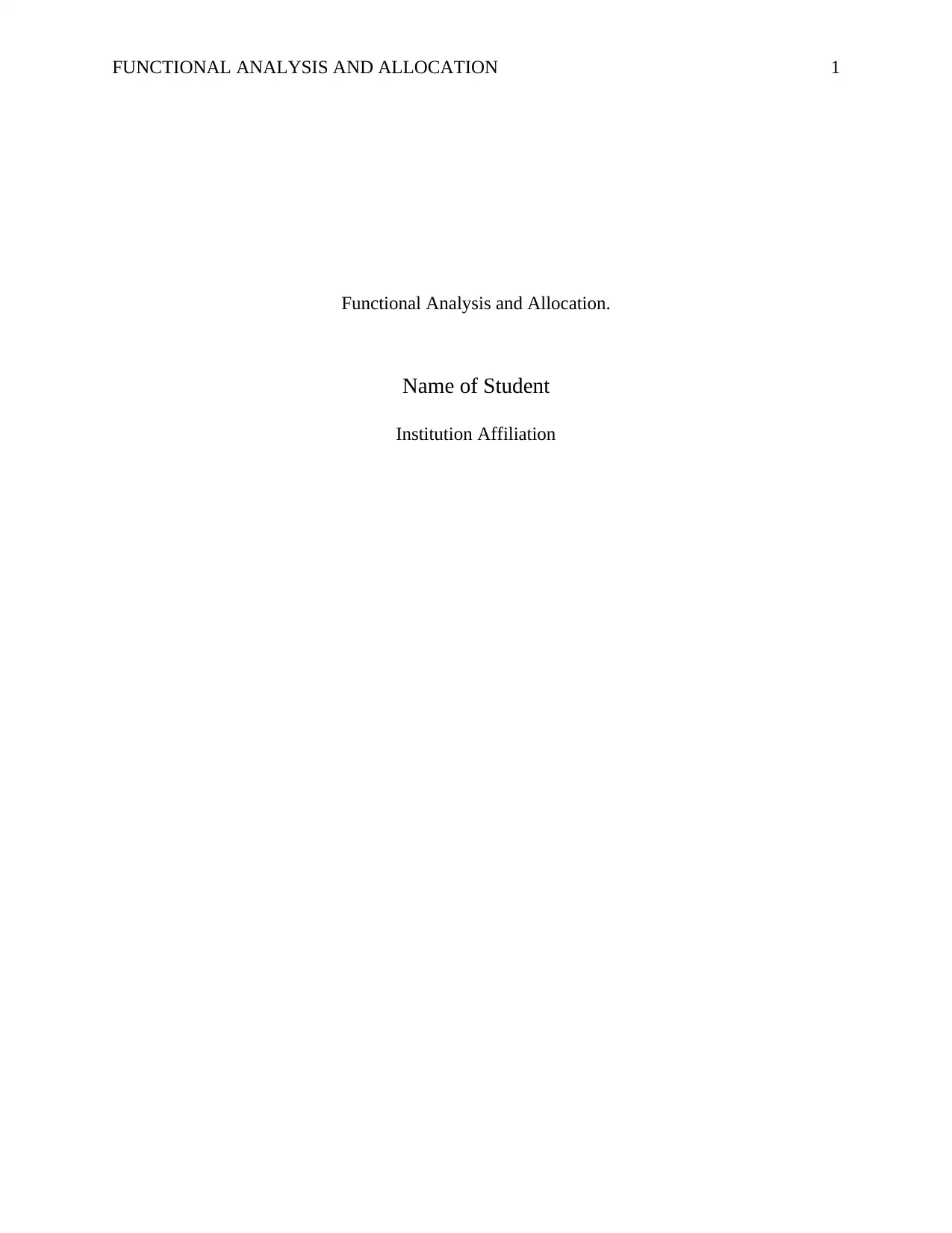
FUNCTIONAL ANALYSIS AND ALLOCATION 1
Functional Analysis and Allocation.
Name of Student
Institution Affiliation
Functional Analysis and Allocation.
Name of Student
Institution Affiliation
Paraphrase This Document
Need a fresh take? Get an instant paraphrase of this document with our AI Paraphraser
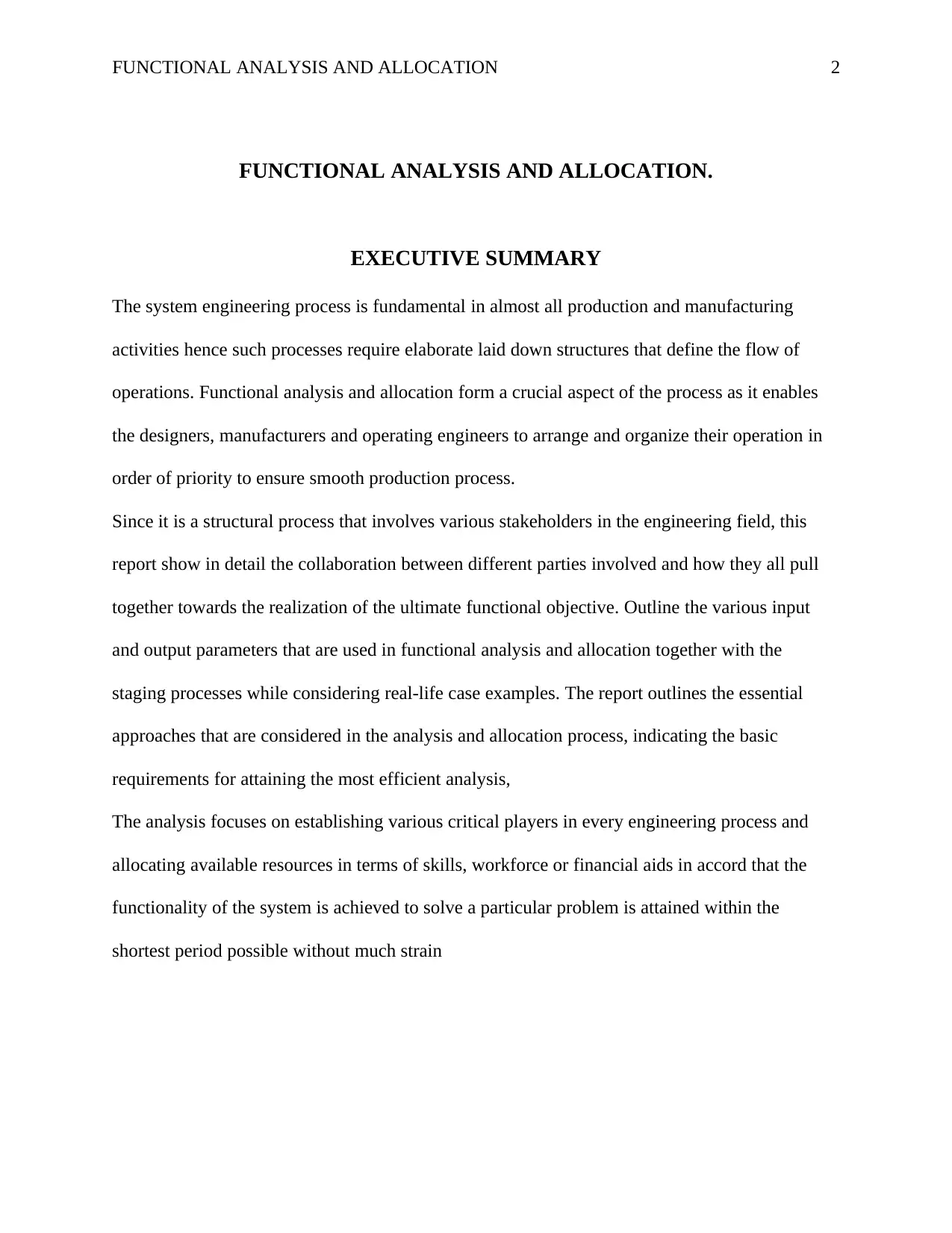
FUNCTIONAL ANALYSIS AND ALLOCATION 2
FUNCTIONAL ANALYSIS AND ALLOCATION.
EXECUTIVE SUMMARY
The system engineering process is fundamental in almost all production and manufacturing
activities hence such processes require elaborate laid down structures that define the flow of
operations. Functional analysis and allocation form a crucial aspect of the process as it enables
the designers, manufacturers and operating engineers to arrange and organize their operation in
order of priority to ensure smooth production process.
Since it is a structural process that involves various stakeholders in the engineering field, this
report show in detail the collaboration between different parties involved and how they all pull
together towards the realization of the ultimate functional objective. Outline the various input
and output parameters that are used in functional analysis and allocation together with the
staging processes while considering real-life case examples. The report outlines the essential
approaches that are considered in the analysis and allocation process, indicating the basic
requirements for attaining the most efficient analysis,
The analysis focuses on establishing various critical players in every engineering process and
allocating available resources in terms of skills, workforce or financial aids in accord that the
functionality of the system is achieved to solve a particular problem is attained within the
shortest period possible without much strain
FUNCTIONAL ANALYSIS AND ALLOCATION.
EXECUTIVE SUMMARY
The system engineering process is fundamental in almost all production and manufacturing
activities hence such processes require elaborate laid down structures that define the flow of
operations. Functional analysis and allocation form a crucial aspect of the process as it enables
the designers, manufacturers and operating engineers to arrange and organize their operation in
order of priority to ensure smooth production process.
Since it is a structural process that involves various stakeholders in the engineering field, this
report show in detail the collaboration between different parties involved and how they all pull
together towards the realization of the ultimate functional objective. Outline the various input
and output parameters that are used in functional analysis and allocation together with the
staging processes while considering real-life case examples. The report outlines the essential
approaches that are considered in the analysis and allocation process, indicating the basic
requirements for attaining the most efficient analysis,
The analysis focuses on establishing various critical players in every engineering process and
allocating available resources in terms of skills, workforce or financial aids in accord that the
functionality of the system is achieved to solve a particular problem is attained within the
shortest period possible without much strain
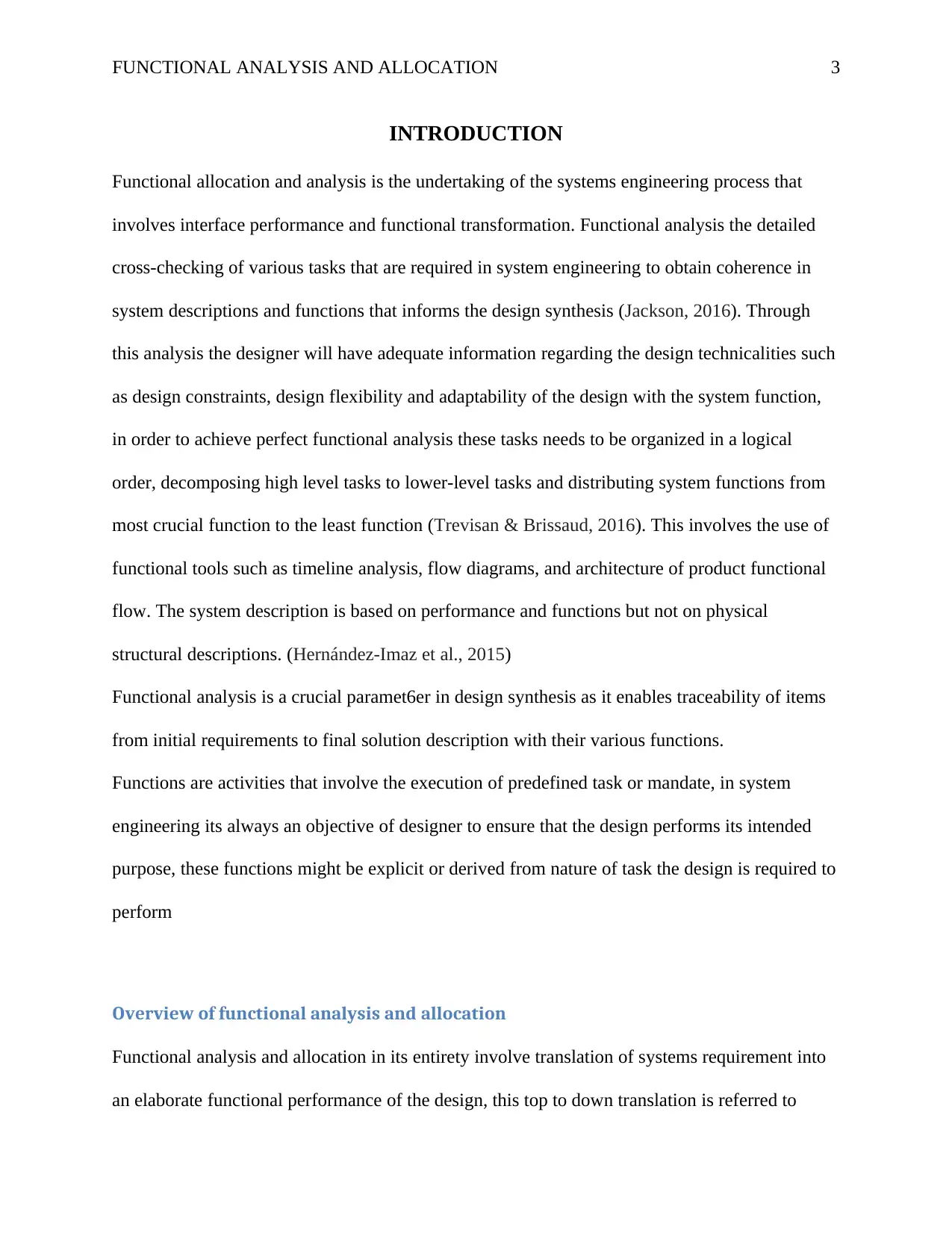
FUNCTIONAL ANALYSIS AND ALLOCATION 3
INTRODUCTION
Functional allocation and analysis is the undertaking of the systems engineering process that
involves interface performance and functional transformation. Functional analysis the detailed
cross-checking of various tasks that are required in system engineering to obtain coherence in
system descriptions and functions that informs the design synthesis (Jackson, 2016). Through
this analysis the designer will have adequate information regarding the design technicalities such
as design constraints, design flexibility and adaptability of the design with the system function,
in order to achieve perfect functional analysis these tasks needs to be organized in a logical
order, decomposing high level tasks to lower-level tasks and distributing system functions from
most crucial function to the least function (Trevisan & Brissaud, 2016). This involves the use of
functional tools such as timeline analysis, flow diagrams, and architecture of product functional
flow. The system description is based on performance and functions but not on physical
structural descriptions. (Hernández-Imaz et al., 2015)
Functional analysis is a crucial paramet6er in design synthesis as it enables traceability of items
from initial requirements to final solution description with their various functions.
Functions are activities that involve the execution of predefined task or mandate, in system
engineering its always an objective of designer to ensure that the design performs its intended
purpose, these functions might be explicit or derived from nature of task the design is required to
perform
Overview of functional analysis and allocation
Functional analysis and allocation in its entirety involve translation of systems requirement into
an elaborate functional performance of the design, this top to down translation is referred to
INTRODUCTION
Functional allocation and analysis is the undertaking of the systems engineering process that
involves interface performance and functional transformation. Functional analysis the detailed
cross-checking of various tasks that are required in system engineering to obtain coherence in
system descriptions and functions that informs the design synthesis (Jackson, 2016). Through
this analysis the designer will have adequate information regarding the design technicalities such
as design constraints, design flexibility and adaptability of the design with the system function,
in order to achieve perfect functional analysis these tasks needs to be organized in a logical
order, decomposing high level tasks to lower-level tasks and distributing system functions from
most crucial function to the least function (Trevisan & Brissaud, 2016). This involves the use of
functional tools such as timeline analysis, flow diagrams, and architecture of product functional
flow. The system description is based on performance and functions but not on physical
structural descriptions. (Hernández-Imaz et al., 2015)
Functional analysis is a crucial paramet6er in design synthesis as it enables traceability of items
from initial requirements to final solution description with their various functions.
Functions are activities that involve the execution of predefined task or mandate, in system
engineering its always an objective of designer to ensure that the design performs its intended
purpose, these functions might be explicit or derived from nature of task the design is required to
perform
Overview of functional analysis and allocation
Functional analysis and allocation in its entirety involve translation of systems requirement into
an elaborate functional performance of the design, this top to down translation is referred to
⊘ This is a preview!⊘
Do you want full access?
Subscribe today to unlock all pages.

Trusted by 1+ million students worldwide
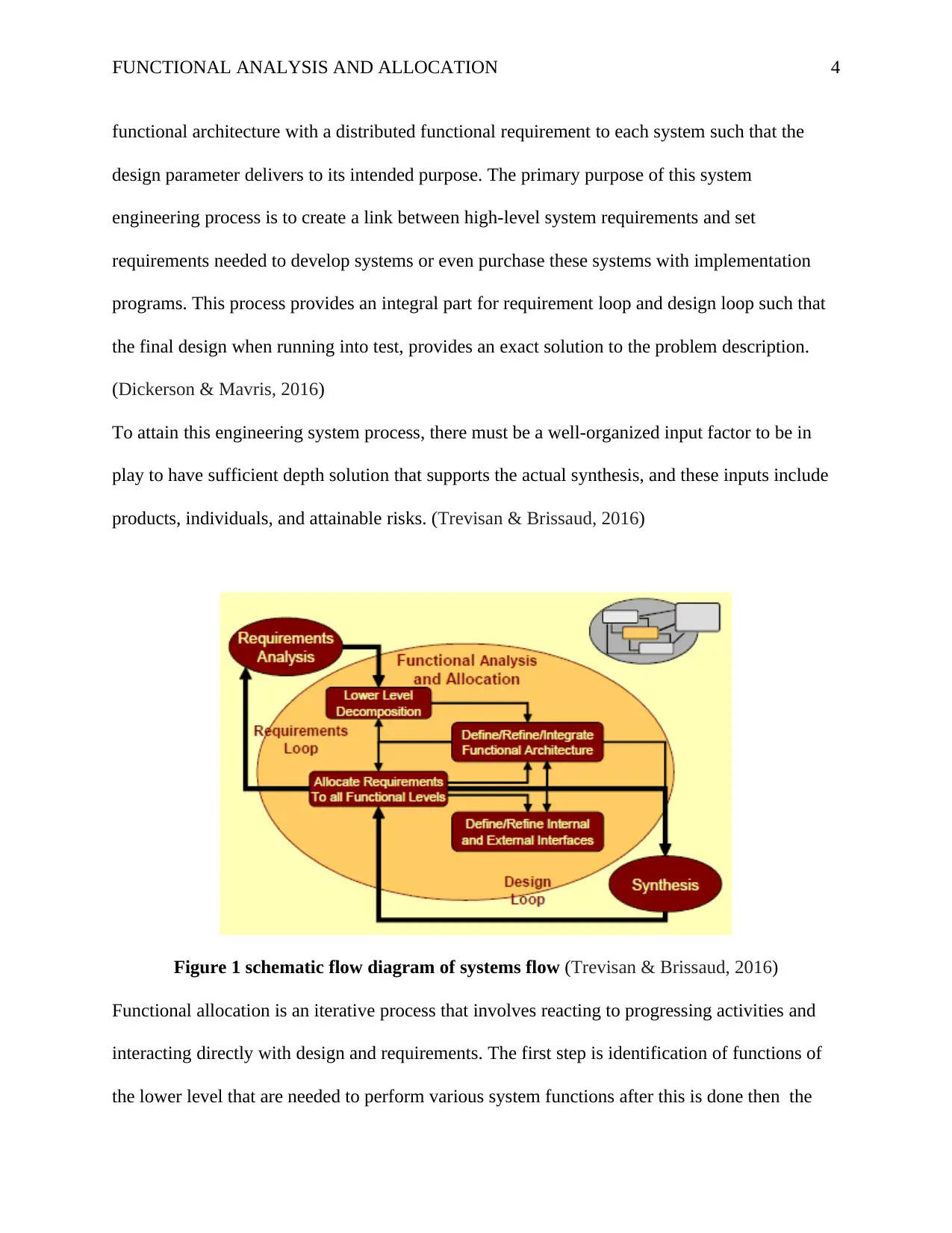
FUNCTIONAL ANALYSIS AND ALLOCATION 4
functional architecture with a distributed functional requirement to each system such that the
design parameter delivers to its intended purpose. The primary purpose of this system
engineering process is to create a link between high-level system requirements and set
requirements needed to develop systems or even purchase these systems with implementation
programs. This process provides an integral part for requirement loop and design loop such that
the final design when running into test, provides an exact solution to the problem description.
(Dickerson & Mavris, 2016)
To attain this engineering system process, there must be a well-organized input factor to be in
play to have sufficient depth solution that supports the actual synthesis, and these inputs include
products, individuals, and attainable risks. (Trevisan & Brissaud, 2016)
Figure 1 schematic flow diagram of systems flow (Trevisan & Brissaud, 2016)
Functional allocation is an iterative process that involves reacting to progressing activities and
interacting directly with design and requirements. The first step is identification of functions of
the lower level that are needed to perform various system functions after this is done then the
functional architecture with a distributed functional requirement to each system such that the
design parameter delivers to its intended purpose. The primary purpose of this system
engineering process is to create a link between high-level system requirements and set
requirements needed to develop systems or even purchase these systems with implementation
programs. This process provides an integral part for requirement loop and design loop such that
the final design when running into test, provides an exact solution to the problem description.
(Dickerson & Mavris, 2016)
To attain this engineering system process, there must be a well-organized input factor to be in
play to have sufficient depth solution that supports the actual synthesis, and these inputs include
products, individuals, and attainable risks. (Trevisan & Brissaud, 2016)
Figure 1 schematic flow diagram of systems flow (Trevisan & Brissaud, 2016)
Functional allocation is an iterative process that involves reacting to progressing activities and
interacting directly with design and requirements. The first step is identification of functions of
the lower level that are needed to perform various system functions after this is done then the
Paraphrase This Document
Need a fresh take? Get an instant paraphrase of this document with our AI Paraphraser

FUNCTIONAL ANALYSIS AND ALLOCATION 5
development of functional architecture with allocation of system requirements. These activities
evolve progressively as the input parameters interact sufficiently to allow continuous validation.
Alternative allocation within the architecture is only applicable at the early stage of the process
until optimum approach becomes more eminent. Functional requirements and architecture are the
primary inputs for the process. Upon completion of the design loop, all the findings and results
of the synthesis are cross-checked with the candidate architecture and allocated requirements to
facilitate in zero in on the optimum approach that ensures that all proposed solution is as per the
initial requirements. Inputs of functional analysis and allocation is an elemental requirement for
system design that is required to be achieved at the end of design process, properly functioning
database, data flow diagrams, timelines, behavior diagrams, tools and models, allocation sheets
and a multi-discipline product team
Staging of financial analysis and allocation process involves sequential stages; it starts with
system modes and state definitions outlining into details the course and reason for the analysis,
then followed by external interfaces and system function definition, functional interface
description, performance allocation, system performance analysis, timing, effects of failure
mode analysis with their criticalities, establishment of fault detection and recovery then finally
integration of different functional units. (Dickerson & Mavris, 2016)
Outputs of functional analysis and allocation are functional architectures that entail the final
specifications of the design process that serves the intended purpose together with the supporting
details. (Erbe, 2017)
development of functional architecture with allocation of system requirements. These activities
evolve progressively as the input parameters interact sufficiently to allow continuous validation.
Alternative allocation within the architecture is only applicable at the early stage of the process
until optimum approach becomes more eminent. Functional requirements and architecture are the
primary inputs for the process. Upon completion of the design loop, all the findings and results
of the synthesis are cross-checked with the candidate architecture and allocated requirements to
facilitate in zero in on the optimum approach that ensures that all proposed solution is as per the
initial requirements. Inputs of functional analysis and allocation is an elemental requirement for
system design that is required to be achieved at the end of design process, properly functioning
database, data flow diagrams, timelines, behavior diagrams, tools and models, allocation sheets
and a multi-discipline product team
Staging of financial analysis and allocation process involves sequential stages; it starts with
system modes and state definitions outlining into details the course and reason for the analysis,
then followed by external interfaces and system function definition, functional interface
description, performance allocation, system performance analysis, timing, effects of failure
mode analysis with their criticalities, establishment of fault detection and recovery then finally
integration of different functional units. (Dickerson & Mavris, 2016)
Outputs of functional analysis and allocation are functional architectures that entail the final
specifications of the design process that serves the intended purpose together with the supporting
details. (Erbe, 2017)
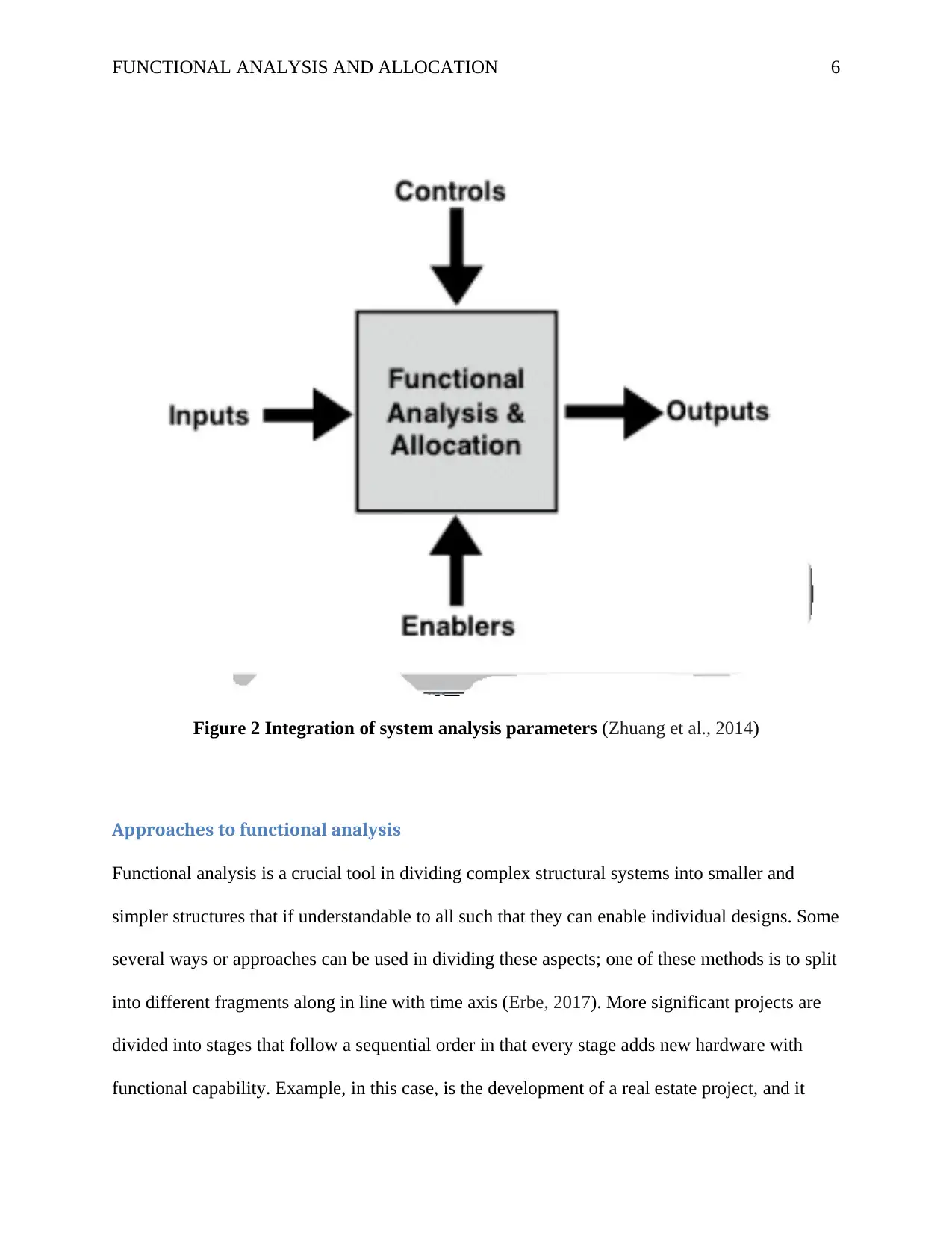
FUNCTIONAL ANALYSIS AND ALLOCATION 6
Figure 2 Integration of system analysis parameters (Zhuang et al., 2014)
Approaches to functional analysis
Functional analysis is a crucial tool in dividing complex structural systems into smaller and
simpler structures that if understandable to all such that they can enable individual designs. Some
several ways or approaches can be used in dividing these aspects; one of these methods is to split
into different fragments along in line with time axis (Erbe, 2017). More significant projects are
divided into stages that follow a sequential order in that every stage adds new hardware with
functional capability. Example, in this case, is the development of a real estate project, and it
Figure 2 Integration of system analysis parameters (Zhuang et al., 2014)
Approaches to functional analysis
Functional analysis is a crucial tool in dividing complex structural systems into smaller and
simpler structures that if understandable to all such that they can enable individual designs. Some
several ways or approaches can be used in dividing these aspects; one of these methods is to split
into different fragments along in line with time axis (Erbe, 2017). More significant projects are
divided into stages that follow a sequential order in that every stage adds new hardware with
functional capability. Example, in this case, is the development of a real estate project, and it
⊘ This is a preview!⊘
Do you want full access?
Subscribe today to unlock all pages.

Trusted by 1+ million students worldwide
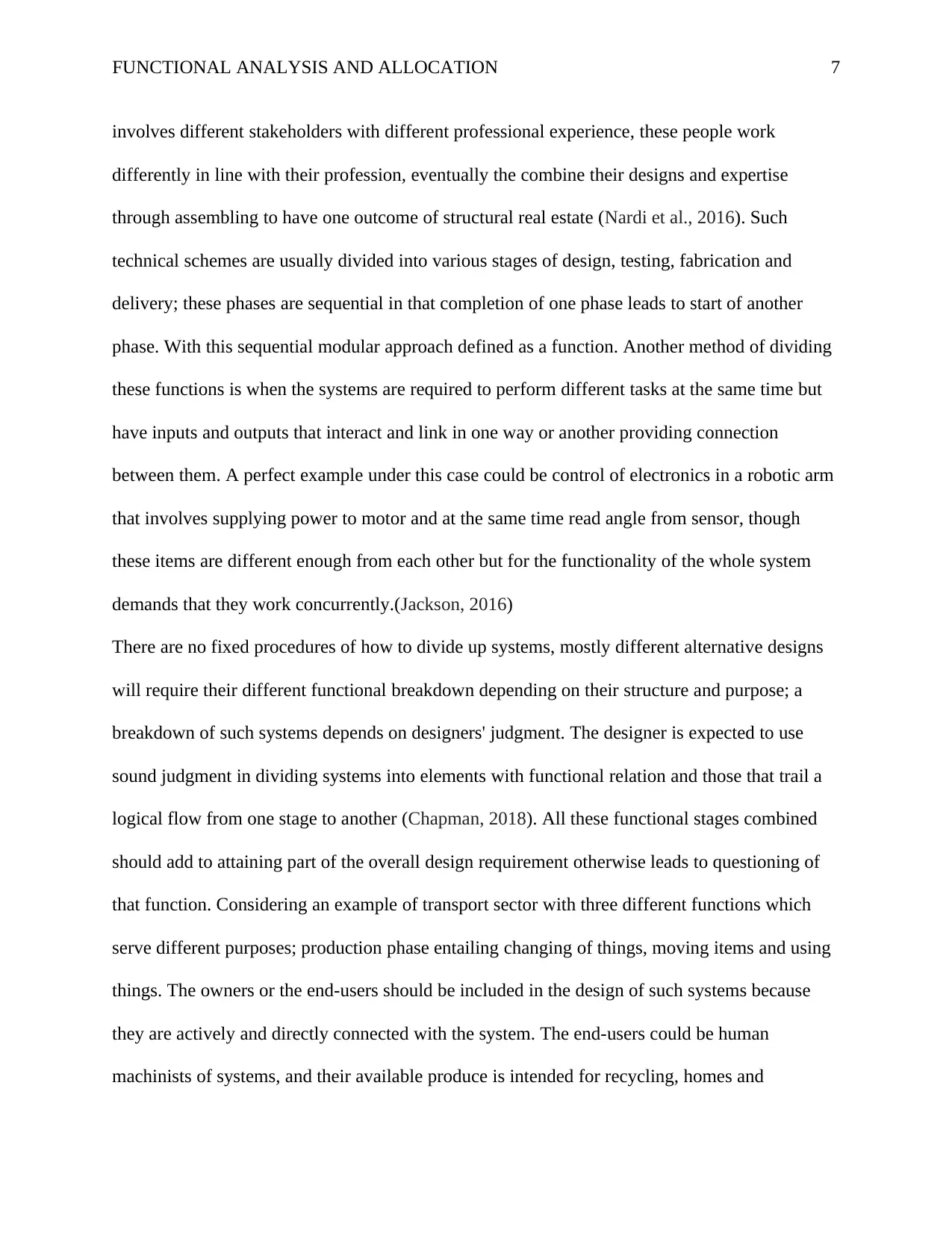
FUNCTIONAL ANALYSIS AND ALLOCATION 7
involves different stakeholders with different professional experience, these people work
differently in line with their profession, eventually the combine their designs and expertise
through assembling to have one outcome of structural real estate (Nardi et al., 2016). Such
technical schemes are usually divided into various stages of design, testing, fabrication and
delivery; these phases are sequential in that completion of one phase leads to start of another
phase. With this sequential modular approach defined as a function. Another method of dividing
these functions is when the systems are required to perform different tasks at the same time but
have inputs and outputs that interact and link in one way or another providing connection
between them. A perfect example under this case could be control of electronics in a robotic arm
that involves supplying power to motor and at the same time read angle from sensor, though
these items are different enough from each other but for the functionality of the whole system
demands that they work concurrently.(Jackson, 2016)
There are no fixed procedures of how to divide up systems, mostly different alternative designs
will require their different functional breakdown depending on their structure and purpose; a
breakdown of such systems depends on designers' judgment. The designer is expected to use
sound judgment in dividing systems into elements with functional relation and those that trail a
logical flow from one stage to another (Chapman, 2018). All these functional stages combined
should add to attaining part of the overall design requirement otherwise leads to questioning of
that function. Considering an example of transport sector with three different functions which
serve different purposes; production phase entailing changing of things, moving items and using
things. The owners or the end-users should be included in the design of such systems because
they are actively and directly connected with the system. The end-users could be human
machinists of systems, and their available produce is intended for recycling, homes and
involves different stakeholders with different professional experience, these people work
differently in line with their profession, eventually the combine their designs and expertise
through assembling to have one outcome of structural real estate (Nardi et al., 2016). Such
technical schemes are usually divided into various stages of design, testing, fabrication and
delivery; these phases are sequential in that completion of one phase leads to start of another
phase. With this sequential modular approach defined as a function. Another method of dividing
these functions is when the systems are required to perform different tasks at the same time but
have inputs and outputs that interact and link in one way or another providing connection
between them. A perfect example under this case could be control of electronics in a robotic arm
that involves supplying power to motor and at the same time read angle from sensor, though
these items are different enough from each other but for the functionality of the whole system
demands that they work concurrently.(Jackson, 2016)
There are no fixed procedures of how to divide up systems, mostly different alternative designs
will require their different functional breakdown depending on their structure and purpose; a
breakdown of such systems depends on designers' judgment. The designer is expected to use
sound judgment in dividing systems into elements with functional relation and those that trail a
logical flow from one stage to another (Chapman, 2018). All these functional stages combined
should add to attaining part of the overall design requirement otherwise leads to questioning of
that function. Considering an example of transport sector with three different functions which
serve different purposes; production phase entailing changing of things, moving items and using
things. The owners or the end-users should be included in the design of such systems because
they are actively and directly connected with the system. The end-users could be human
machinists of systems, and their available produce is intended for recycling, homes and
Paraphrase This Document
Need a fresh take? Get an instant paraphrase of this document with our AI Paraphraser
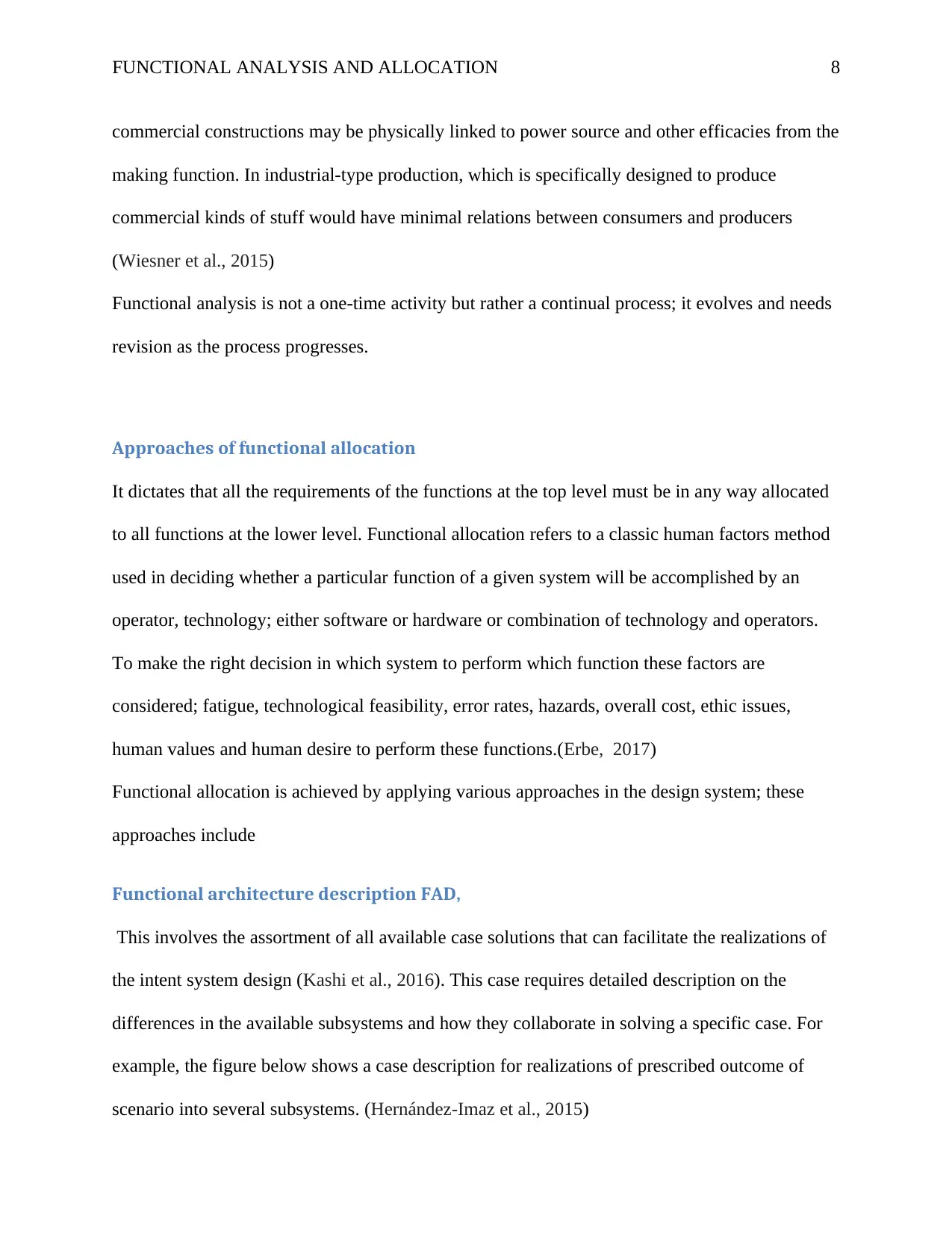
FUNCTIONAL ANALYSIS AND ALLOCATION 8
commercial constructions may be physically linked to power source and other efficacies from the
making function. In industrial-type production, which is specifically designed to produce
commercial kinds of stuff would have minimal relations between consumers and producers
(Wiesner et al., 2015)
Functional analysis is not a one-time activity but rather a continual process; it evolves and needs
revision as the process progresses.
Approaches of functional allocation
It dictates that all the requirements of the functions at the top level must be in any way allocated
to all functions at the lower level. Functional allocation refers to a classic human factors method
used in deciding whether a particular function of a given system will be accomplished by an
operator, technology; either software or hardware or combination of technology and operators.
To make the right decision in which system to perform which function these factors are
considered; fatigue, technological feasibility, error rates, hazards, overall cost, ethic issues,
human values and human desire to perform these functions.(Erbe, 2017)
Functional allocation is achieved by applying various approaches in the design system; these
approaches include
Functional architecture description FAD,
This involves the assortment of all available case solutions that can facilitate the realizations of
the intent system design (Kashi et al., 2016). This case requires detailed description on the
differences in the available subsystems and how they collaborate in solving a specific case. For
example, the figure below shows a case description for realizations of prescribed outcome of
scenario into several subsystems. (Hernández-Imaz et al., 2015)
commercial constructions may be physically linked to power source and other efficacies from the
making function. In industrial-type production, which is specifically designed to produce
commercial kinds of stuff would have minimal relations between consumers and producers
(Wiesner et al., 2015)
Functional analysis is not a one-time activity but rather a continual process; it evolves and needs
revision as the process progresses.
Approaches of functional allocation
It dictates that all the requirements of the functions at the top level must be in any way allocated
to all functions at the lower level. Functional allocation refers to a classic human factors method
used in deciding whether a particular function of a given system will be accomplished by an
operator, technology; either software or hardware or combination of technology and operators.
To make the right decision in which system to perform which function these factors are
considered; fatigue, technological feasibility, error rates, hazards, overall cost, ethic issues,
human values and human desire to perform these functions.(Erbe, 2017)
Functional allocation is achieved by applying various approaches in the design system; these
approaches include
Functional architecture description FAD,
This involves the assortment of all available case solutions that can facilitate the realizations of
the intent system design (Kashi et al., 2016). This case requires detailed description on the
differences in the available subsystems and how they collaborate in solving a specific case. For
example, the figure below shows a case description for realizations of prescribed outcome of
scenario into several subsystems. (Hernández-Imaz et al., 2015)
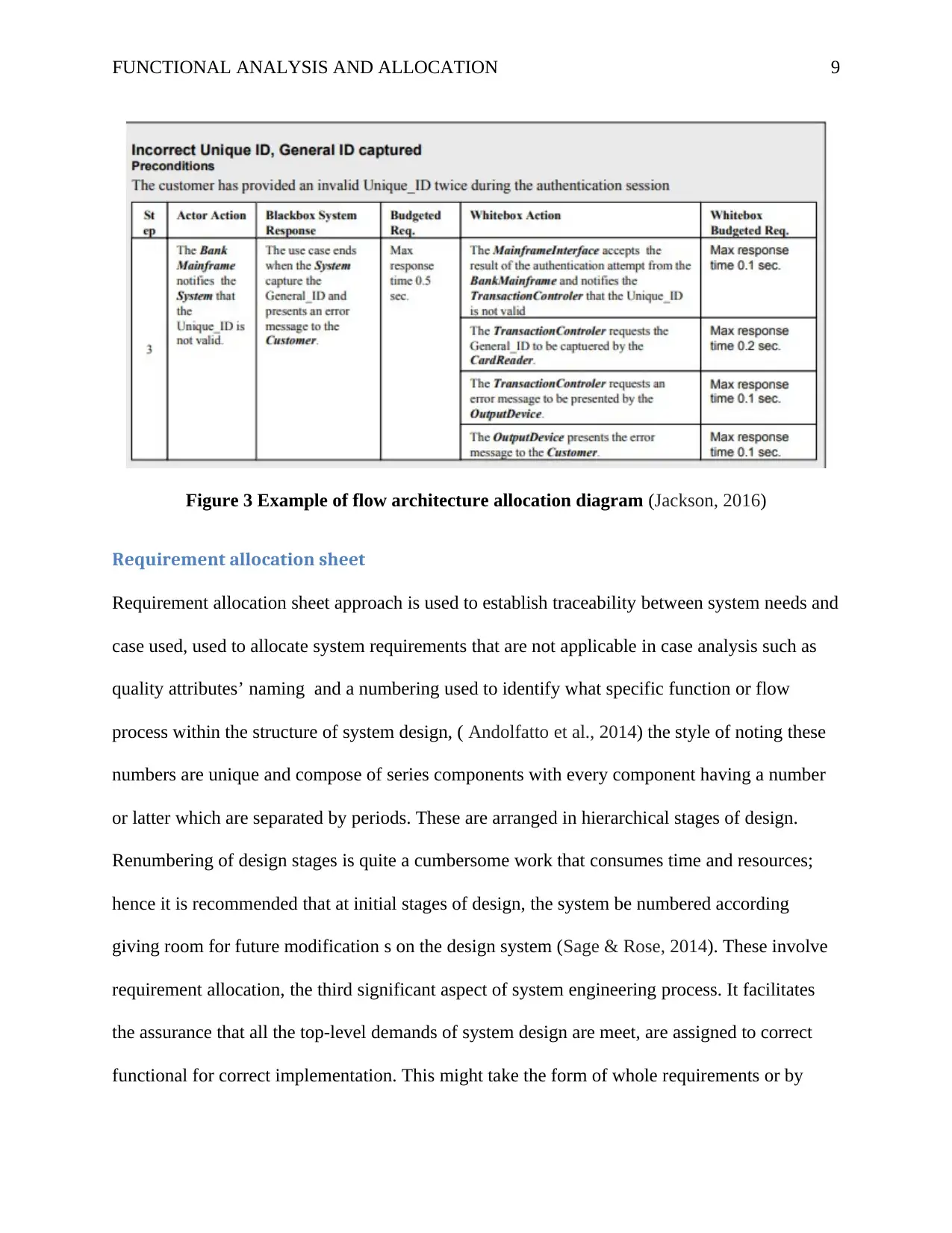
FUNCTIONAL ANALYSIS AND ALLOCATION 9
Figure 3 Example of flow architecture allocation diagram (Jackson, 2016)
Requirement allocation sheet
Requirement allocation sheet approach is used to establish traceability between system needs and
case used, used to allocate system requirements that are not applicable in case analysis such as
quality attributes’ naming and a numbering used to identify what specific function or flow
process within the structure of system design, ( Andolfatto et al., 2014) the style of noting these
numbers are unique and compose of series components with every component having a number
or latter which are separated by periods. These are arranged in hierarchical stages of design.
Renumbering of design stages is quite a cumbersome work that consumes time and resources;
hence it is recommended that at initial stages of design, the system be numbered according
giving room for future modification s on the design system (Sage & Rose, 2014). These involve
requirement allocation, the third significant aspect of system engineering process. It facilitates
the assurance that all the top-level demands of system design are meet, are assigned to correct
functional for correct implementation. This might take the form of whole requirements or by
Figure 3 Example of flow architecture allocation diagram (Jackson, 2016)
Requirement allocation sheet
Requirement allocation sheet approach is used to establish traceability between system needs and
case used, used to allocate system requirements that are not applicable in case analysis such as
quality attributes’ naming and a numbering used to identify what specific function or flow
process within the structure of system design, ( Andolfatto et al., 2014) the style of noting these
numbers are unique and compose of series components with every component having a number
or latter which are separated by periods. These are arranged in hierarchical stages of design.
Renumbering of design stages is quite a cumbersome work that consumes time and resources;
hence it is recommended that at initial stages of design, the system be numbered according
giving room for future modification s on the design system (Sage & Rose, 2014). These involve
requirement allocation, the third significant aspect of system engineering process. It facilitates
the assurance that all the top-level demands of system design are meet, are assigned to correct
functional for correct implementation. This might take the form of whole requirements or by
⊘ This is a preview!⊘
Do you want full access?
Subscribe today to unlock all pages.

Trusted by 1+ million students worldwide
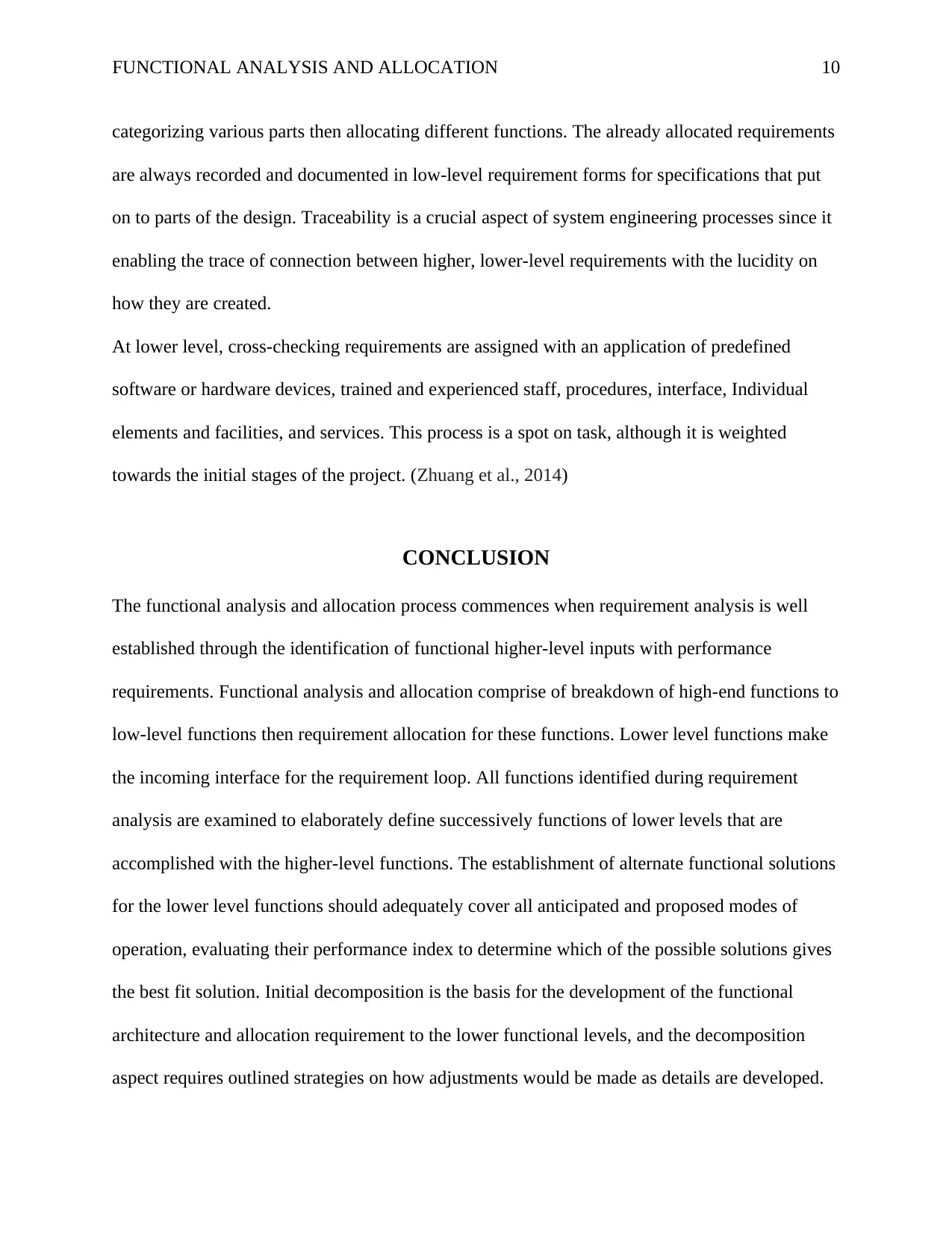
FUNCTIONAL ANALYSIS AND ALLOCATION 10
categorizing various parts then allocating different functions. The already allocated requirements
are always recorded and documented in low-level requirement forms for specifications that put
on to parts of the design. Traceability is a crucial aspect of system engineering processes since it
enabling the trace of connection between higher, lower-level requirements with the lucidity on
how they are created.
At lower level, cross-checking requirements are assigned with an application of predefined
software or hardware devices, trained and experienced staff, procedures, interface, Individual
elements and facilities, and services. This process is a spot on task, although it is weighted
towards the initial stages of the project. (Zhuang et al., 2014)
CONCLUSION
The functional analysis and allocation process commences when requirement analysis is well
established through the identification of functional higher-level inputs with performance
requirements. Functional analysis and allocation comprise of breakdown of high-end functions to
low-level functions then requirement allocation for these functions. Lower level functions make
the incoming interface for the requirement loop. All functions identified during requirement
analysis are examined to elaborately define successively functions of lower levels that are
accomplished with the higher-level functions. The establishment of alternate functional solutions
for the lower level functions should adequately cover all anticipated and proposed modes of
operation, evaluating their performance index to determine which of the possible solutions gives
the best fit solution. Initial decomposition is the basis for the development of the functional
architecture and allocation requirement to the lower functional levels, and the decomposition
aspect requires outlined strategies on how adjustments would be made as details are developed.
categorizing various parts then allocating different functions. The already allocated requirements
are always recorded and documented in low-level requirement forms for specifications that put
on to parts of the design. Traceability is a crucial aspect of system engineering processes since it
enabling the trace of connection between higher, lower-level requirements with the lucidity on
how they are created.
At lower level, cross-checking requirements are assigned with an application of predefined
software or hardware devices, trained and experienced staff, procedures, interface, Individual
elements and facilities, and services. This process is a spot on task, although it is weighted
towards the initial stages of the project. (Zhuang et al., 2014)
CONCLUSION
The functional analysis and allocation process commences when requirement analysis is well
established through the identification of functional higher-level inputs with performance
requirements. Functional analysis and allocation comprise of breakdown of high-end functions to
low-level functions then requirement allocation for these functions. Lower level functions make
the incoming interface for the requirement loop. All functions identified during requirement
analysis are examined to elaborately define successively functions of lower levels that are
accomplished with the higher-level functions. The establishment of alternate functional solutions
for the lower level functions should adequately cover all anticipated and proposed modes of
operation, evaluating their performance index to determine which of the possible solutions gives
the best fit solution. Initial decomposition is the basis for the development of the functional
architecture and allocation requirement to the lower functional levels, and the decomposition
aspect requires outlined strategies on how adjustments would be made as details are developed.
Paraphrase This Document
Need a fresh take? Get an instant paraphrase of this document with our AI Paraphraser
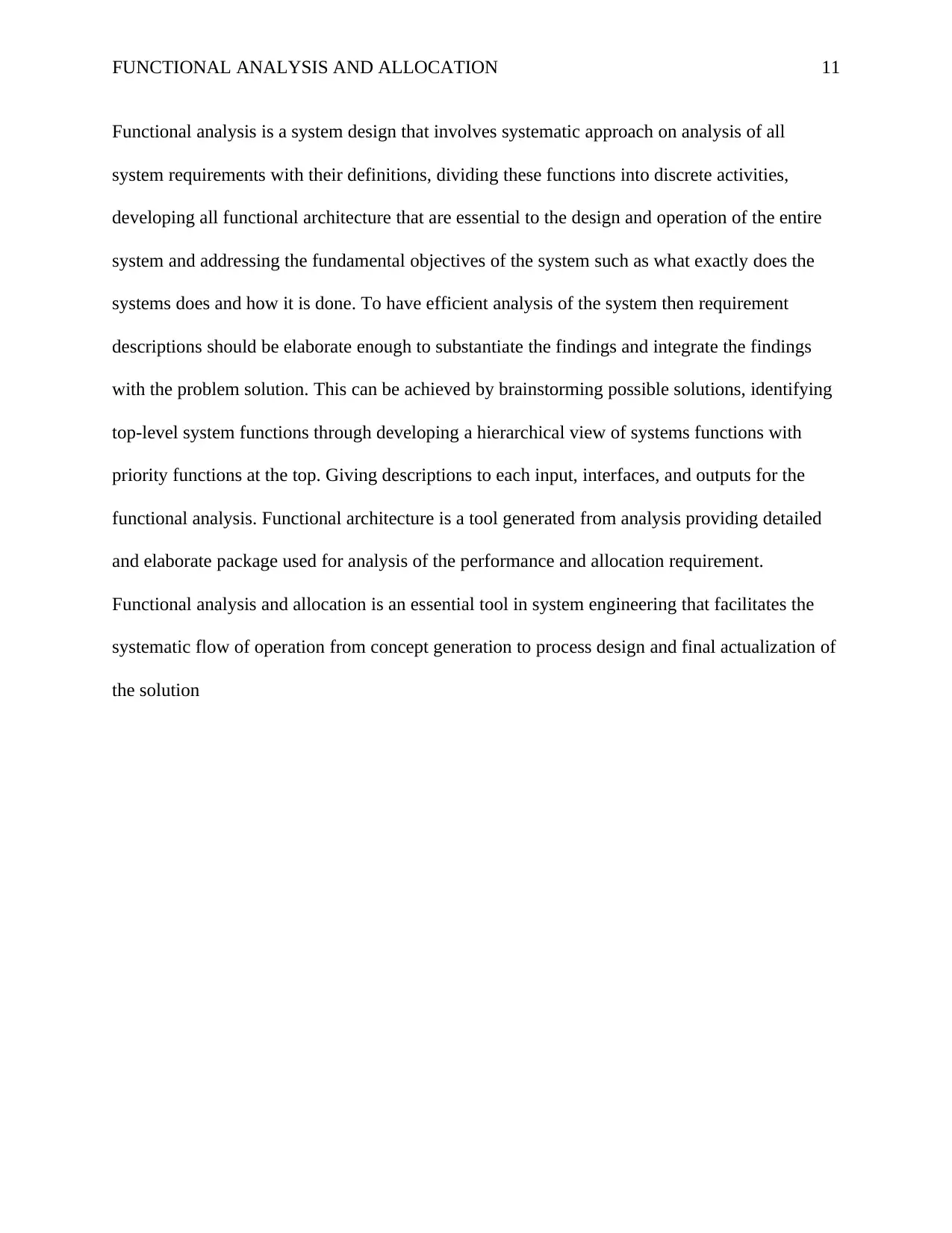
FUNCTIONAL ANALYSIS AND ALLOCATION 11
Functional analysis is a system design that involves systematic approach on analysis of all
system requirements with their definitions, dividing these functions into discrete activities,
developing all functional architecture that are essential to the design and operation of the entire
system and addressing the fundamental objectives of the system such as what exactly does the
systems does and how it is done. To have efficient analysis of the system then requirement
descriptions should be elaborate enough to substantiate the findings and integrate the findings
with the problem solution. This can be achieved by brainstorming possible solutions, identifying
top-level system functions through developing a hierarchical view of systems functions with
priority functions at the top. Giving descriptions to each input, interfaces, and outputs for the
functional analysis. Functional architecture is a tool generated from analysis providing detailed
and elaborate package used for analysis of the performance and allocation requirement.
Functional analysis and allocation is an essential tool in system engineering that facilitates the
systematic flow of operation from concept generation to process design and final actualization of
the solution
Functional analysis is a system design that involves systematic approach on analysis of all
system requirements with their definitions, dividing these functions into discrete activities,
developing all functional architecture that are essential to the design and operation of the entire
system and addressing the fundamental objectives of the system such as what exactly does the
systems does and how it is done. To have efficient analysis of the system then requirement
descriptions should be elaborate enough to substantiate the findings and integrate the findings
with the problem solution. This can be achieved by brainstorming possible solutions, identifying
top-level system functions through developing a hierarchical view of systems functions with
priority functions at the top. Giving descriptions to each input, interfaces, and outputs for the
functional analysis. Functional architecture is a tool generated from analysis providing detailed
and elaborate package used for analysis of the performance and allocation requirement.
Functional analysis and allocation is an essential tool in system engineering that facilitates the
systematic flow of operation from concept generation to process design and final actualization of
the solution
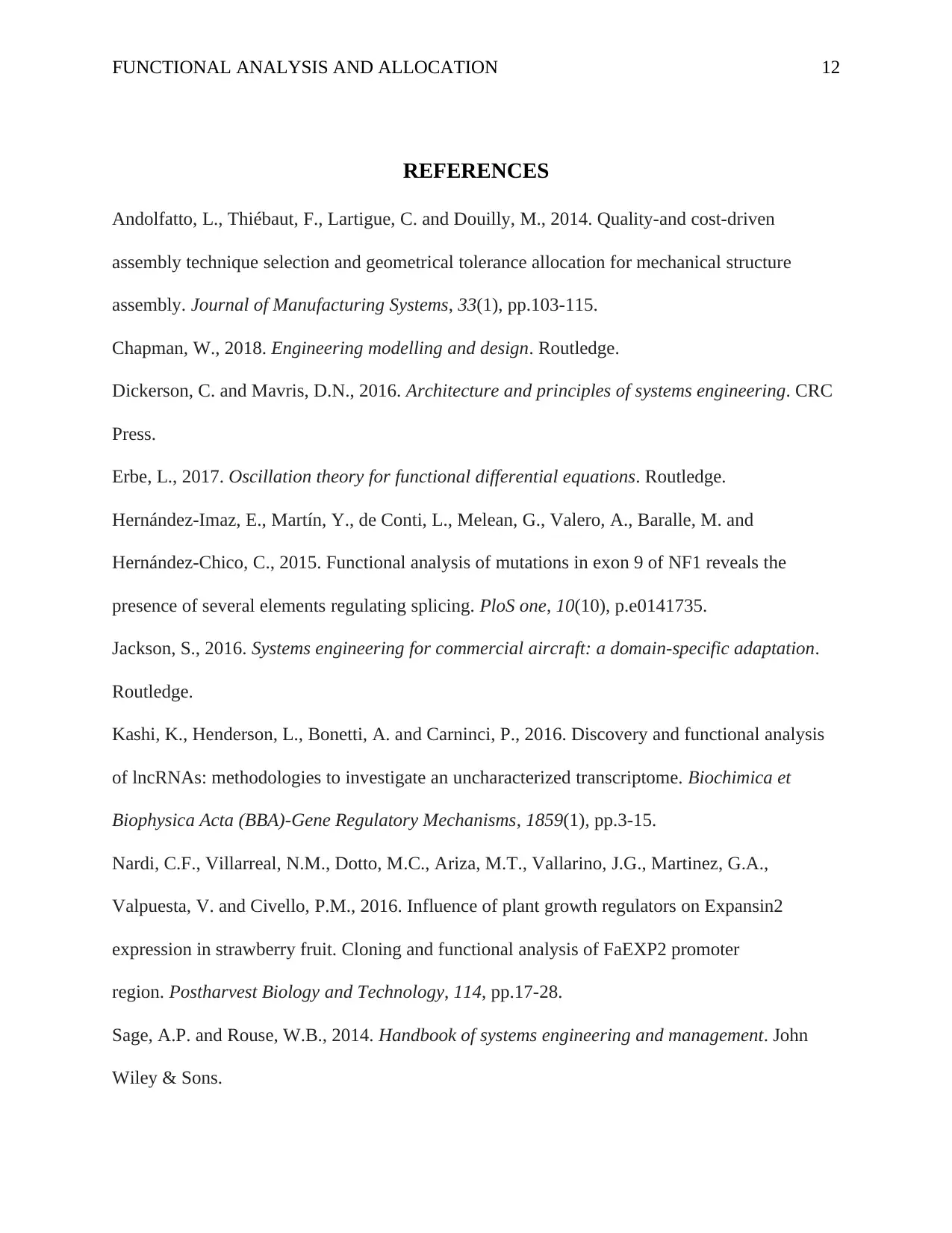
FUNCTIONAL ANALYSIS AND ALLOCATION 12
REFERENCES
Andolfatto, L., Thiébaut, F., Lartigue, C. and Douilly, M., 2014. Quality-and cost-driven
assembly technique selection and geometrical tolerance allocation for mechanical structure
assembly. Journal of Manufacturing Systems, 33(1), pp.103-115.
Chapman, W., 2018. Engineering modelling and design. Routledge.
Dickerson, C. and Mavris, D.N., 2016. Architecture and principles of systems engineering. CRC
Press.
Erbe, L., 2017. Oscillation theory for functional differential equations. Routledge.
Hernández-Imaz, E., Martín, Y., de Conti, L., Melean, G., Valero, A., Baralle, M. and
Hernández-Chico, C., 2015. Functional analysis of mutations in exon 9 of NF1 reveals the
presence of several elements regulating splicing. PloS one, 10(10), p.e0141735.
Jackson, S., 2016. Systems engineering for commercial aircraft: a domain-specific adaptation.
Routledge.
Kashi, K., Henderson, L., Bonetti, A. and Carninci, P., 2016. Discovery and functional analysis
of lncRNAs: methodologies to investigate an uncharacterized transcriptome. Biochimica et
Biophysica Acta (BBA)-Gene Regulatory Mechanisms, 1859(1), pp.3-15.
Nardi, C.F., Villarreal, N.M., Dotto, M.C., Ariza, M.T., Vallarino, J.G., Martinez, G.A.,
Valpuesta, V. and Civello, P.M., 2016. Influence of plant growth regulators on Expansin2
expression in strawberry fruit. Cloning and functional analysis of FaEXP2 promoter
region. Postharvest Biology and Technology, 114, pp.17-28.
Sage, A.P. and Rouse, W.B., 2014. Handbook of systems engineering and management. John
Wiley & Sons.
REFERENCES
Andolfatto, L., Thiébaut, F., Lartigue, C. and Douilly, M., 2014. Quality-and cost-driven
assembly technique selection and geometrical tolerance allocation for mechanical structure
assembly. Journal of Manufacturing Systems, 33(1), pp.103-115.
Chapman, W., 2018. Engineering modelling and design. Routledge.
Dickerson, C. and Mavris, D.N., 2016. Architecture and principles of systems engineering. CRC
Press.
Erbe, L., 2017. Oscillation theory for functional differential equations. Routledge.
Hernández-Imaz, E., Martín, Y., de Conti, L., Melean, G., Valero, A., Baralle, M. and
Hernández-Chico, C., 2015. Functional analysis of mutations in exon 9 of NF1 reveals the
presence of several elements regulating splicing. PloS one, 10(10), p.e0141735.
Jackson, S., 2016. Systems engineering for commercial aircraft: a domain-specific adaptation.
Routledge.
Kashi, K., Henderson, L., Bonetti, A. and Carninci, P., 2016. Discovery and functional analysis
of lncRNAs: methodologies to investigate an uncharacterized transcriptome. Biochimica et
Biophysica Acta (BBA)-Gene Regulatory Mechanisms, 1859(1), pp.3-15.
Nardi, C.F., Villarreal, N.M., Dotto, M.C., Ariza, M.T., Vallarino, J.G., Martinez, G.A.,
Valpuesta, V. and Civello, P.M., 2016. Influence of plant growth regulators on Expansin2
expression in strawberry fruit. Cloning and functional analysis of FaEXP2 promoter
region. Postharvest Biology and Technology, 114, pp.17-28.
Sage, A.P. and Rouse, W.B., 2014. Handbook of systems engineering and management. John
Wiley & Sons.
⊘ This is a preview!⊘
Do you want full access?
Subscribe today to unlock all pages.

Trusted by 1+ million students worldwide
1 out of 13
Related Documents
Your All-in-One AI-Powered Toolkit for Academic Success.
+13062052269
info@desklib.com
Available 24*7 on WhatsApp / Email
![[object Object]](/_next/static/media/star-bottom.7253800d.svg)
Unlock your academic potential
Copyright © 2020–2025 A2Z Services. All Rights Reserved. Developed and managed by ZUCOL.



